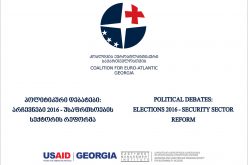On June 11, 2019, EWMI ACCESS grantee The Georgian Alliance for Safe Roads (GASR) presented the results of their comparative analysis of air quality data in Tbilisi. GASR compared the first quarters of 2018 and 2019, focusing on the emission of Nitrogen Dioxide (NO2) and Particulate Matter (PM2.5 and PM10). These air pollutants reduce immunity to lung infections and increase the likelihood of respiratory problems.
The air quality data was taken from Tsereteli Avenue – one of the busiest streets in Tbilisi where an air quality measuring station is located. GASR commissioned the SMART-AtmoSim Lab of Tbilisi State University to conduct a comparative analysis using data from the National Environmental Agency air quality portal.
The analysis showed that the level of NO2 contamination has increased from 33% above the acceptable limit (2018) to 58% (2019). Likewise, the excess of PM2.5 has increased from 15% to 16%. CO emissions are below the norm. The main source of NO2 contamination is internal combustion engine vehicles, while sources for PM2.5 are constructions, outworn wheels weights, and others.
It is worth noting that the current vehicle Periodic Technical Inspection (PTI) controls only CO emissions (as the data indicated, this pollutant is below the norm) and does not look into NO2 and other important pollutants. These are the pollutants that are reduced by catalytic converters. Checking for catalytic converters will become a mandatory part of PTIs in 2020.
EWMI ACCESS and GASR plan to use this data to call for more effective measures to reduce air pollution in Tbilisi and other parts of Georgia, as well as to mobilize public support for more comprehensive PTIs.















